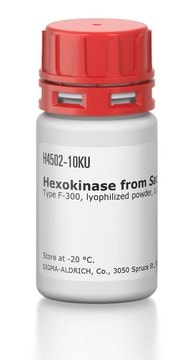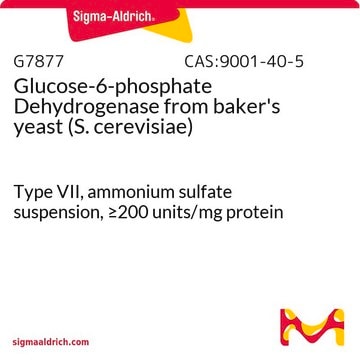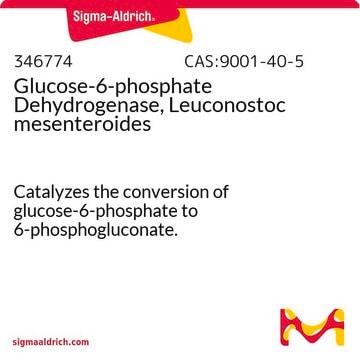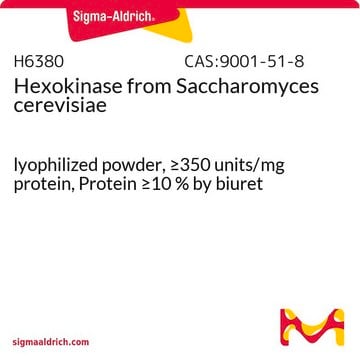G4134
Glucose-6-phosphate Dehydrogenase from baker′s yeast (S. cerevisiae)
Type IX, lyophilized powder, 200-400 units/mg protein (modified Warburg-Christian)
Synonym(s):
G-6-P-DH, Zwischenferment
Sign Into View Organizational & Contract Pricing
All Photos(1)
About This Item
Recommended Products
type
Type IX
Quality Level
form
lyophilized powder
specific activity
200-400 units/mg protein (modified Warburg-Christian)
mol wt
128 kDa
β-NADP and β-NADPH content
≤10 mmol/mol
application(s)
agriculture
shipped in
dry ice
storage temp.
−20°C
Looking for similar products? Visit Product Comparison Guide
Related Categories
General description
Research area: Cell Signaling
Glucose-6-phosphate dehydrogenase (G6PD) is a key metabolic enzyme of the pentose phosphate pathway. In S. cerevisiae, it is encoded by the ZWF1 gene. G6PD exists as a tetramer in its active form.
Glucose-6-phosphate dehydrogenase (G6PD) is a key metabolic enzyme of the pentose phosphate pathway. In S. cerevisiae, it is encoded by the ZWF1 gene. G6PD exists as a tetramer in its active form.
Application
Glucose-6-phosphate dehydrogenase is used:
- To test ketose reductase activity in developing maize endosperm.
- For recycling microassay of β-NADP and β-NADPH.
- To measure the intracellular levels of NADPH and total NADP.
- To measure the nicotinamide adenine dinucleotide (NAD) kinase kinetic assay activity.
Biochem/physiol Actions
Glucose-6-phosphate dehydrogenase catalyzes the conversion of glucose-6-phosphate to 6-phosphogluconolacetone as the first step in the pentose phosphate pathway.
Glucose-6-phosphate dehydrogenase catalyzes the rate-limiting step in the pentose phosphate pathway. Its function involves the conversion of glucose-6-phosphate to 6-phosphogluconolacetone while generating NADPH, which is essential for the regeneration of glutathione The glutathione system utilizes nicotinamide adenine dinucleotide phosphate hydrogen (NADPH) to effectively eliminate excess hydrogen peroxide. Glucose-6-phosphate dehydrogenase (G6PD) plays an important role in regulating cell growth and survival. Their levels are higher in cells undergoing normal and neoplastic growth. Increased glucose-6-phosphate dehydrogenase activity plays a pivotal role in preventing reactive oxygen species mediated cell death. Glucose-6-phosphate dehydrogenase is over expressed in several cancers whereas its activity is reduced in hyperglycemia. A deficiency in glucose-6-phosphate dehydrogenase causes hemolysis.
Unit Definition
One unit will oxidize 1.0 μmole of D-glucose 6-phosphate to 6-phospho-D-gluconate per min in the presence of NADP at pH 7.4 at 25 °C.
Physical form
Lyophilized powder essentially sulfate-free, containing approx. 20% sodium citrate
Signal Word
Danger
Hazard Statements
Precautionary Statements
Hazard Classifications
Resp. Sens. 1
Storage Class Code
11 - Combustible Solids
WGK
WGK 3
Flash Point(F)
Not applicable
Flash Point(C)
Not applicable
Personal Protective Equipment
dust mask type N95 (US), Eyeshields, Gloves
Certificates of Analysis (COA)
Search for Certificates of Analysis (COA) by entering the products Lot/Batch Number. Lot and Batch Numbers can be found on a product’s label following the words ‘Lot’ or ‘Batch’.
Already Own This Product?
Find documentation for the products that you have recently purchased in the Document Library.
Customers Also Viewed
Revealing the allosterome: systematic identification of metabolite-protein interactions
Orsak T, et al.
Biochemistry, 51(1), 225-232 (2012)
D Oh et al.
Molecular and cellular biology, 10(4), 1415-1422 (1990-04-01)
The Saccharomyces cerevisiae GAL5 (PGM2) gene was isolated and shown to encode the major isozyme of phosphoglucomutase. Northern (RNA) blot hybridization revealed that the GAL5 transcript level increased three- to fourfold in response to galactose and was severely repressed in
The Pentose Phosphate Pathway in Yeasts-More Than a Poor Cousin of Glycolysis
Bertels LK, et al.
Biomolecules, 11(5), 725-725 (2021)
Glucose-6-phosphate dehydrogenase, NADPH, and cell survival
Stanton R C
IUBMB Life, 64(5), 362-369 (2012)
Impact of glucose-6-phosphate dehydrogenase deficiency on the pathophysiology of cardiovascular disease
Hecker PA, et al.
American Journal of Physiology. Heart and Circulatory Physiology, 304(4), H491-H500 (2013)
Our team of scientists has experience in all areas of research including Life Science, Material Science, Chemical Synthesis, Chromatography, Analytical and many others.
Contact Technical Service













